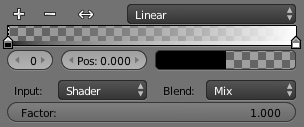Color Ramps¶
Reference
In many real life situations, like skin or metals, the color of diffuse and specular reflections can differ slightly, based on the amount of energy a surface receives or on the light angle of incidence. The Ramp Shader options in Blender allow you to set a range of colors for a Material, and define how the range will vary over a surface, and how it blends with the ‘actual color’ (typically from a material or as output of a texture).
Ramps allow you to precisely control the color gradient across a material, rather than just a simple blend from a brightened color to a darkened color, from the most strongly lit area to the darkest lit area. As well as several options for controlling the gradient from lit to shadowed, ramps also provide ‘normal’ input, to define a gradient from surfaces facing the camera to surfaces facing away from the camera. This is often used for materials like some types of metallic car paint that change color based on viewing angle.
Since texture calculations in Blender happen before shading, the Ramp Shader can completely replace texture or material color. But by use of the mixing options and Alpha values it is possible to create an additional layer of shading in Blender materials.
Options¶

Ramps Panel.
For the first part of the color ramp option see Color Ramp Widget.
- Input
The input menu contains the following options for defining the gradient:
- Shader
- The value as delivered by the material’s shader (Lambert, Cook Torrance) defines the color. Here the amount of light does not matter for color, only the direction of the light.
- Energy
- As Shader, now also lamp energy, color, and distance are taken into account. This makes the material change color when more light shines on it.
- Normal
- The surface normal, relative to the camera, is used for the Ramp Shader. This is possible with a texture as well, but added for convenience.
- Result
- While all three previous options work per lamp, this option only works after shading calculations. This allows full control over the entire shading, including ‘Toon’ style results. Using alpha values here is most useful for tweaking a finishing touch to a material.
- Blend
- A list of the various Color Blend Modes are available for blending the ramp shader with the color from Input.
- Factor
- This slider denotes the overall factor of the ramp shader with the color from Input.